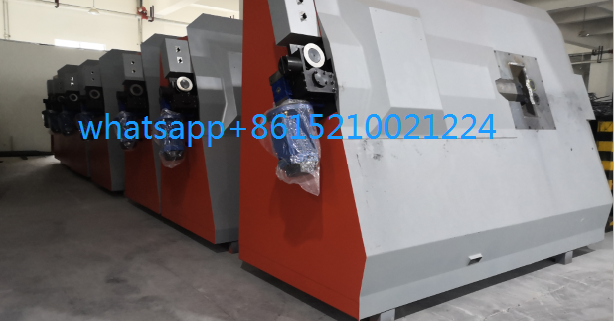Automatic Stirrup Bending Machine Won’t Cut Wire? Diagnose & Fix stirrup bender Fast!
Automatic Stirrup Bending Machine Won’t Cut Wire? Diagnose & Fix stirrup bender Fast! Is your automatic stirrup bending machine humming along with the rebar bending arm but completely failing to cut the rebar wire? This sudden halt in production is more than frustrating – it’s costly downtime. Don’t panic! While these machines are robust, the cutting function is a critical point of failure. The most common culprits are dull/damaged blades, incorrect blade clearance, hydraulic/pneumatic pressure loss, or sensor misalignment. Let’s systematically diagnose and solve the “no cut” problem to get you back bending stirrups efficiently.
Itech Best selling CNC high quality automatic stirrup bending machine / CNC stirrup bender machine widely use in reinforcement steel wire bar cut and bend factory. Itech as professional reinforcing steel machine supplier. Itech have a series of steel rebar bender machine,like CNC 16mm Stirrup Bending machine,CNC 20mm stirrup bar bending machine , 14mm stirrup wire bending machine and bar shape machine ,automatic rebar pile cage welding machine,cnc automatic pile cage making machine and many kinds of rebar machine. To solve the gap on the stirrups ,Itech stirrup bending machine adopt advanced anti twist feeding system to avoid twist of steel, make stirrup more quick and standard.Shape and bend stirrups effortlessly with our cutting-edge bending machine.
Automatic Stirrup Bending Machine Won’t Cut Wire? Diagnose & Fix stirrup bender Fast!
- The Obvious Suspect: Cutting Blades & Mechanism (Check First!)
Blade Condition: This is the #1 cause. Inspect the upper and lower shear blades closely.
Are they chipped, cracked, or blunt? Even minor damage prevents a clean cut.
Are they covered in hardened concrete residue or excessive grease? This buildup prevents proper closing and shearing.
Solution: Sharpen or replace the blades immediately. Ensure you use the correct, manufacturer-recommended blades for your wire diameter. Clean blades thoroughly after replacement. Regular blade inspection and maintenance are paramount.
Automatic Stirrup Bending Machine Won’t Cut Wire? Diagnose & Fix stirrup bender Fast!
Blade Clearance (Gap): The gap between the upper and lower blades when open is crucial.
Too large a gap prevents the blades from properly shearing the wire.
Too small a gap causes excessive friction, rapid dulling, and potential jamming.
Solution: Consult your machine’s manual for the exact recommended clearance for the wire size you’re using. Carefully adjust the gap using the provided adjustment mechanisms (often set screws or shims). Use a feeler gauge for precision.
Blade Alignment: Are the blades perfectly aligned vertically? Misalignment causes uneven wear, poor cutting, and strain on the mechanism.
Solution: Visually inspect alignment during the closing cycle (safely!). Adjust alignment bolts if necessary, referring to the manual. Ensure all mounting bolts are tight.
- Power & Pressure: Hydraulic/Pneumatic Systems
Low Hydraulic Pressure/Pneumatic Pressure: The cutting mechanism relies on sufficient force.
Check hydraulic fluid levels. Are they low? Top up with the correct fluid.
Inspect hydraulic hoses and pneumatic lines for leaks, cracks, or kinks. Listen for hissing (air) or look for oil seepage (hydraulic).
Check hydraulic pressure gauges (if equipped) against machine specs. Low pressure could indicate pump issues, valve problems, or internal leaks.
Solution: Fix leaks by replacing lines/fittings. Check and adjust system pressure settings per the manual. If pressure remains low, internal pump or valve issues may require a technician.
Faulty Cutting Cylinder/Solenoid: The cylinder (hydraulic/pneumatic) powers the blade movement. The solenoid valve controls the flow to the cylinder.
Is the cylinder visibly damaged or leaking internally?
Can you hear the solenoid “click” when the cut signal is sent? No click often indicates an electrical issue to the solenoid or a failed solenoid.
Solution: Test solenoid function (electrical signal in, air/hydraulic out). Replace a faulty solenoid. A leaking or seized cylinder will likely need replacement.
- Sensors & Control: The Brain’s Input
Wire Positioning Sensor: This sensor tells the control system the wire is correctly in place for cutting. If it fails or is misaligned:
The machine thinks no wire is present and won’t initiate the cut cycle.
Solution: Clean the sensor lens/target area. Check alignment – ensure the wire reliably triggers the sensor. Test the sensor’s output signal with a multimeter if possible. Replace if faulty.
Cutting Position Sensor/Limit Switch: This sensor confirms the cutting mechanism has fully retracted or is in the “ready” position. If it fails:
The control system might prevent a new cut cycle for safety, thinking the blade is still engaged.
Solution: Manually check the switch activation. Clean and ensure proper mechanical contact. Test and replace if necessary.
Control System Glitch: Less common, but possible.
Solution: Perform a controlled power cycle (turn machine OFF, wait 60 seconds, turn ON). Check for any error codes on the display. Consult the manual for code meanings. If simple resets don’t work, deeper diagnostics or controller repair might be needed.
- Mechanical Binding & Obstructions
Visually inspect the entire cutting mechanism linkage and guides.
Is there bent metal, broken components, or excessive debris (metal shavings, concrete chunks) jamming the movement?
Are guide rollers damaged or seized?
Solution: Clear all debris meticulously. Lubricate moving parts as specified in the manual (some areas require dry lube). Replace damaged guides, linkage pins, or rollers. Ensure everything moves freely by hand (with power OFF!).
When to Call the Professionals:
If you’ve meticulously checked blades, clearance, sensors, pressure lines, and basic mechanics but the cutter still refuses to work, it’s time to escalate:
Suspected Major Hydraulic/Pneumatic Failure: Internal valve blockages, pump failures.
Complex Electrical/Control Issues: Faulty PCBs, deep wiring problems.
Significant Mechanical Damage: Bent shafts, severe gearbox issues.
Safety Concerns: Never force repairs beyond your expertise on powerful machinery.
Prevention is Key:
Strict Blade Maintenance: Regular inspection, cleaning, and timely sharpening/replacement are the BEST way to avoid cutting failures.
Clean Machine: Keep the cutting area free of debris buildup daily.
Correct Settings: Always use the blade gap and pressure settings specified for your wire diameter.
Scheduled Checks: Incorporate sensor checks and lubrication into your routine maintenance schedule.
Automatic Stirrup Bending Machine Won’t Cut Wire? Diagnose & Fix stirrup bender Fast! By methodically working through these steps – starting with the blades and working through power, sensors, and mechanics – you’ll most often identify and resolve the “no cut” issue on your automatic stirrup bender, minimizing costly downtime and keeping your rebar fabrication flowing smoothly. Remember, blade care is your first and most powerful defense!
Itech is professional steel wire/bar processing machinery China supplier,stirrup bending machine price , steel rebar bending machine,foundation pile cage making machine,,steel wire straightener,wire straightening and cutting machine, wire mesh welding machine,rebar shear line,rebar sawing&threading line and related cnc plasma cutting machine, laser cutting machine can meet different customers’ requirement.

 steel reinforcement stirrup bending machine
steel reinforcement stirrup bending machine
 pile cage machine
pile cage machine
Leave a Reply
Want to join the discussion?Feel free to contribute!